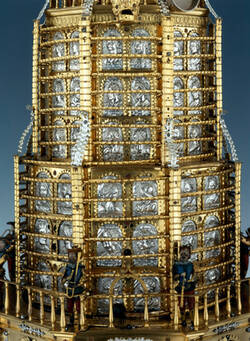That’s probably how the little orchestra on the lower balustrade once sounded. This magnificent Rolling Ball Clock, which Elector Christian the Second gave to his wife Hedwig in 1603, is a masterpiece of the clockmaker’s art. It’s also one of the first devices to produce music mechanically. It’s called a Rolling Ball Clock because every minute a rock crystal ball runs down a track with sixteen bends in it, while a lift mechanism inside the clock raises a second ball. When the ball reaches the end of the track and drops down inside the clock, Saturn up there strikes a bell with his hammer. Twice a day, the musicians on the balustrade raise their instruments. Then a mechanical organ inside the clock plays a melody. The inventor of this ingenious mechanism was none other than Hans Schlottheim – famous for his brilliant figure clocks and automata.
Down below, in niches at the base, you see seven painted, silver figures. They represent the Liberal Arts: Grammar, Rhetoric and Logic; Music, Astronomy, Geometry and Arithmetic.
The two-storied tower chronicles the lineage of the German emperors. They trace the line from Emperor Rudolf the Second right back to Classical Antiquity! Like the Lüneburg Mirror, which you will see later in this exhibition, the decoration of this clock incorporates a specific collection of symbols – it has what art historians call an iconographic programme. Those symbols are intended to convey the idea of empire.
Further Media
- Location & Dating
- probably Augsburg, ca. 1600
- Material & Technique
- Silver, gilt, brass, iron, steel, wood, leather, rock crystal, partly painted, gut string
- Dimenions
- H 112 cm, B 60 cm, T 60 cm
- Museum
- Grünes Gewölbe
- Inventory number
- V 140
